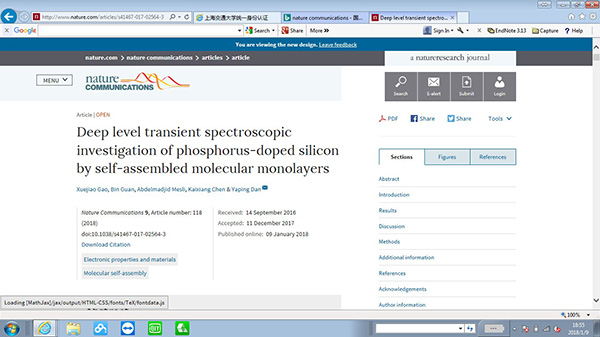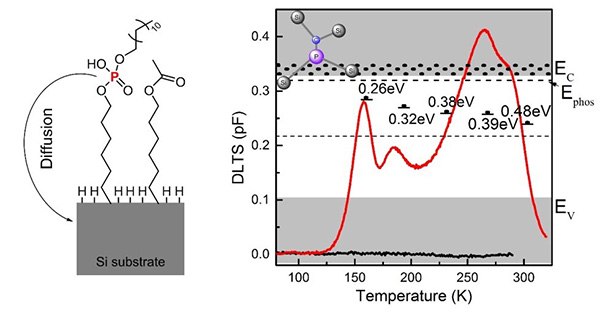Professor Yaping Dan’s research team at the University of Michigan-Shanghai Jiao Tong University Joint Institute (UM-SJTU JI) has published a paper entitled “Deep level transient spectroscopic investigation of phosphorus-doped silicon by self-assembled molecular monolayers”in Nature Communications, revealing that during the self-assembled molecular monolayer doping process, carbon-related defects formed and decreased the ionization rate of phosphorus. This work laid a foundation for commercial application of self-assembled molecular monolayer doping technique. Professor Yaping Dan is the corresponding author. Xuejiao Gao and Dr. Bin Guan are the co-first authors.

Introducing dopants into semiconductors is the key step for creating semiconductor transistors in integrated circuits. Traditionally, dopants are introduced into semiconductors by ion implantation, a technique to bombard the semiconductors with high-speed dopant ions. Clearly, ion implantation will create a lot of physical damages to the semiconductor crystals that will degrade the transistor performance, although the damages can be partially fixed by high temperature annealing. For the state-of-art integrated circuits, the ion implantation technology becomes increasingly difficult to meet the requirements of sub-20nm transistors. The self-assembled molecular monolayer doping technique was believed to a potential technique that can meet these requirements. Many research groups in US and Europe are working on this technique.
The self-assembled molecular monolayer doping technique relies on the self-limiting effect to form a monolayer of molecules on semiconductor surfaces. Each molecular has one or more dopant atoms. This technique has the unique advantages of forming ultra-shallow junction and precisely locating the dopants, while introducing no crystal damage as the ion implantation does. It is suitable for doping on complex geometry structures like the “fins” on fin-FET transistors. In addition, it has potential applications on controlling a single dopant atom. However, there is a major concern that carbon in the molecular may also be introduced into the semiconductor along with the phosphorus dopants, forming carbon defects that will degrade the properties of semiconductors. But no one has ever addressed this concern.

In this published paper, Professor Dan and his team discovered the carbon defects in silicon after the monolayer doping, showing that carbon contamination does degrade the electrical properties of the silicon semiconductor. Advanced techniques were applied to characterize the carbon related defects. “Doping by self-assembled molecular monolayers is a promising and controversial method to replace conventional doping of silicon by a more regular and low cost doping. Several laboratories are considering this method but its reliability has not definitively been proved.” Professor Dan says by quoting the comments from the reviewers of the article, “This work makes a major step to identify significant drawbacks of the method, namely formation of C related traps incorporating P dopants. Therefore, it paves the way to future improvements to make it free from unwanted effects”.
Background Information
 Dr. Yaping Dan is an Associate Professor of electrical engineering at the UM-SJTU Joint Institute. He received his bachelor’s degree in electrical engineering from Xi’an Jiaotong University in 1999, master’s degree in microelectronics from Tsinghua University in 2002, and doctoral degree in electrical engineering from the University of Pennsylvania in 2008. Before he joined the Joint Institute, he was a postdoctoral fellow and then research associate at Harvard University. He won the postdoctoral fellowship award from the US National Academies in 2009 and the prestigious “National 1000 Young Scholars” award from Chinese Central Government in June, 2012. He served as the editorial board member of Scientific Reports since 2016 and an adjunct professor at Xi’an Jiaotong University since 2017.
Dr. Yaping Dan is an Associate Professor of electrical engineering at the UM-SJTU Joint Institute. He received his bachelor’s degree in electrical engineering from Xi’an Jiaotong University in 1999, master’s degree in microelectronics from Tsinghua University in 2002, and doctoral degree in electrical engineering from the University of Pennsylvania in 2008. Before he joined the Joint Institute, he was a postdoctoral fellow and then research associate at Harvard University. He won the postdoctoral fellowship award from the US National Academies in 2009 and the prestigious “National 1000 Young Scholars” award from Chinese Central Government in June, 2012. He served as the editorial board member of Scientific Reports since 2016 and an adjunct professor at Xi’an Jiaotong University since 2017.





